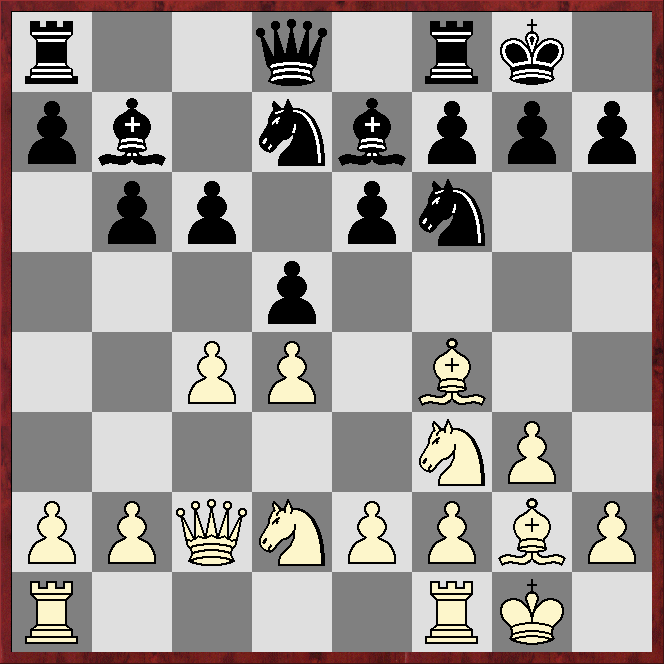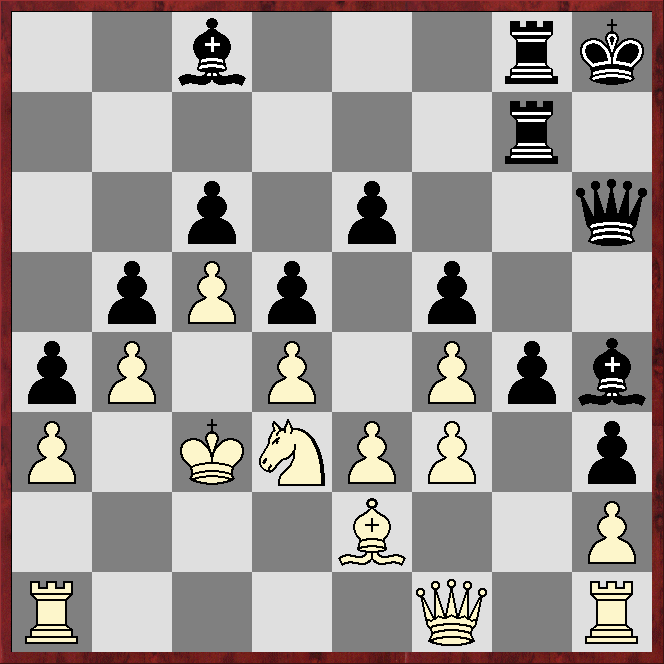Adam Sixsmith (1698) - Spanton (1955)
Pimlico Round Four*
Catalan
1.d4 d5 2.c4 e6 3.Nf3 Nf6 4.g3 Bb4+ 5.Bd2 Be7
The point of this fairly well-known manoeuvre is to 'misplace' the white dark-square bishop, the argument being it belongs on b2 to support action on the e5 square. The mainline in ChessBase's 2022 Mega database after 4.g3 runs 4...Be7 5.Bg2 0-0 6.0-0, when Black can continue along Closed Catalan lines with 6...c6 7.Qc2 b6 8.Nbd2 Bb7 9.b3 Nbd7 10.Bb2 Rac8.
 |
| This position occurs 826 times in Mega22, with White scoring a very respectable 57% |
6.Bg2 0-0 7.0-0 c6 8.Qc2 b6 9.Bf4
The bishop redeploys to a more active square, one point being to free d2 for the queen's knight.
9...Bb7 10.Nbd2 Nbd7
 |
| This position occurs 142 times in Mega22, with White scoring an excellent 59% |
11.Rac1 Rc8 12.Rfe1!?
This is strongly disliked by the engines. Stockfish15 gives 12.a3 Re8 13.b4 c5 14.dxc5 bxc5 15.b5, claiming equality. Komodo13.02 prefers 12.Ne5 Nh5 13.Nd3 Nxf4 14.Nxf4, also reckoning the position is equal.
12...Re8
12...c5!? is enough for at least a slight edge, according to the engines, eg 13.Bg5!? dxc4 14.Qxc4 h6 15.Be3 Ng4.
13.Ne5 Nh5 14.Ndf3 Nxf4 15.gxf4
 |
| Black is slightly better, according to the engines |
15...f5?
This prevents a quick e4 or f5, not that White necessarily wants to play either pawn thrust, but leaves a serious hole at e5 and does the black light-square bishop no favours.
16.Nxd7 Qxd7 17.Ne5 Qd8
 |
| There is no question of the bishop-pair being an advantage in this position - the knight is too strong and there are too many pawns on the board |
The engines prefer the more-conservative 18...Bd6.
19.Nd3
The engines reckon White should try for an initiative on the queenside, eg 19.Qa4!? a6 20.cxd5 cxd5 21.Rxc8 Qxc8, followed by switching to kingside play with 22.Qd1!?
19...g4
The engines prefer 19...gxf4 20.exf4!? Bf6 with approximate equality.
20.c5
20.Qa4 a6 21.Qb3 gives White an advantage, according to the engines.
20...b5?!
Almost certainly not 20...bxc5? 21.Nxc5, but the engines reckon this is a good time to activate the light-square bishop with 20...Ba6!?, and if 21.Nb4 then 21...Bc4 22.b3 bxc5 seems to give Black at least equality.
21.b4
Possibly stronger is the engines' 21.a4, when Black is more-or-less obliged to reply 21...a6, leaving all eight black pawns on light squares.
21...a5 22.a3
The engines prefer 22.a4 with queenside pressure.
22...Ra8 23.Ra1 Ra6
Closing the queenside with 23...a4 may be better.
24.Ra2
The engines like more-active queenside play with 24.a4!?, the point being Black's bishops are not well-placed for action on the a and b files.
24...Qa8 25.Rea1 Qa7?
This loses, according to the engines, although they reckon White is well on top after, for example, 25...a4 26.f3
*****
*****
*****
*****
26.Kf1
White is better after this, according to the engines, but 26.a4!?, threatening 27.axb5 is very strong, eg 26...bxa4 27.Rxa4 axb4 28.Rxa6 Bxa6 29.Nxb4, or 26...axb4 27.axb5 Rxa2 28.Rxa2 Qb8 28.b6, or 26...Ra8 27.axb5 cxb5 28.bxa5.
26...Ra8 27.Nc1?!
Almost certainly too passive. 27.f3 leaves Black badly placed for kingside play, and if 27...axb4 then simply 28.Nxb4.
27...Qb8 28.Ke2 Kh8 29.f3 h5 30.Kd3?!
The king heads for safety on the queenside, but it is a long-winded process that gives Black time to reorganise for kingside play. The engines prefer 30.Nd3 or 30.gxf4.
30...Qf8 31.Kc3 Qh6 32.Qf2 Rg8 33.Nd3 Bf6 34.Kb3?!
This gives Black a tempo to shut the queenside.
34...a4+ 35.Kc3 Ra7 36.Rh1 h4 37.Raa1 h3 38.Bf1 Bc8 39.Be2 Bh4 40.Qf1 Rag7
 |
| All the black pieces, except for the light-square bishop, are concentrated on the kingside, and the black position looks threatening, but the engines reckon White has an edge |
*****
*****
*****
*****
41.Ne5 Bb7?
Black had to play 41...gxf3 42.Qxf3 Bd7.
42.Kd3?
42.fxg4 fxg4 43.Rg1 wins, eg 43...Qh5 44.Rxg4 Rxg4 45.Bxg4 Rxg4 46.Qf3 etc.
42...Bf6?
42...gxf3 more-or-less equalises.
43.Qf2?
Again fxg4 is strong, eg 43...fxg4 44.Rg1 Bxe5 45.fxe5 g3 46.Qf6! Qxf6 47.exf6 Rg6 48.f7 Rf8 49.Rxg3 Rxg3 50.hxg3 Rxf7 51.Rh1 Rh7 52.Rh2 etc The engines reckon 47...Rf7!? is better, but 48.Rxg3 Rxg3 49.hxg3 Rxf6 50.Rh1 is still good for White.
43...Bxe5 44.fxe5 g3 45.hxg3 Rxg3
*****
*****
*****
*****
46.Rag1?
46.f4 is fairly obvious and good, but 46.Bf1!? probably also holds, according to the engines.
*****
*****
*****
*****
46...f4?
The right idea, but the wrong move-order. Correct is 46...Rxg1 47.Rxg1 Rxg1 48.Qxg1 h2 49.Qh1 f4! (threatening 50...Qg6+ and 51...Qg1), eg 50.e4 Qh4 51.Bf1 Qf2 52.Bg2 Qg1 53.Ke2 Bc8 54.Kd3 Bd7 55.Ke2 Be8 etc.
*****
*****
*****
*****
47.e4??
The engines reckon 47.Bf1! gives dead-eye equality. The text is catastrophic.
47...dxe4+ 48.Kxe4 Qg6+ 49.Kxf4
*****
*****
*****
49...Rxg1?
I had meant to play 49...Qg5+ 50.Ke4 Rxg1+?, when White does not have an immediate Qh4+, but after 51.Rxg1 Qxg1 White has a draw with 52.Qh4+ Kg7 53.Qf6+ etc.
Winning is 49...Qh6+ 50.Ke4 Rxg1 51.Rxg1 Rxg1 52.Qxg1 h2 53.Qh1 Qg6+ etc. So in the previous line White also has a win with 50...Qg6+ followed by 51...Qh6+ and 52...Rxg1 etc.
50.Qh4+ Kg7 51.Qe7+?
51.Rxg1 Qxg1 52.Qf6+ draws.
51...Qf7+
After the text AS tried to play 52.Rxg1+ till I pointed out he was in check (0-1, 63 moves).
*I took half-point byes in rounds two and three because of other chess commitments.





No comments:
Post a Comment